The Digital Divide as a Barrier: Ethical Issues and Solutions
VerifiedAdded on 2023/04/21
|5
|1150
|422
Essay
AI Summary
This essay examines the digital divide as a significant barrier to internet and technology access, differentiating between those who have access and those who do not, based on factors like location, literacy, and economic status. It discusses the ethical issues arising from this divide at both national and global levels, including the impact of income, geographical location, IT knowledge, and internet availability. The role of education in mitigating the digital divide is explored, highlighting initiatives like BYOD (Bring Your Own Device) and its potential benefits and drawbacks. Furthermore, the essay proposes solutions such as extending affordability, empowering users through education, and developing relevant local content to bridge the digital divide. It emphasizes the importance of addressing poverty, infrastructure, and illiteracy to promote equitable access to technology and the internet.
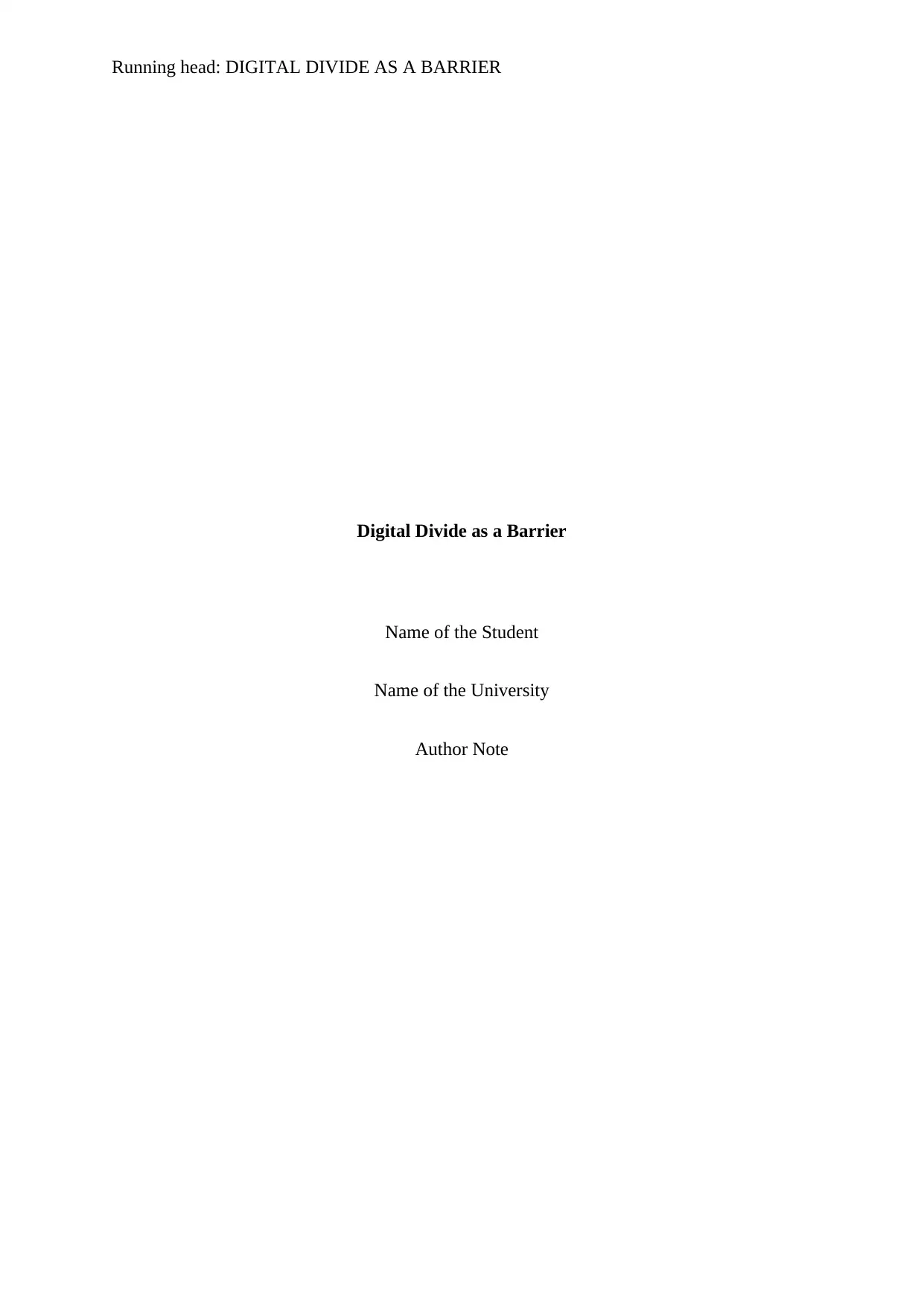
Running head: DIGITAL DIVIDE AS A BARRIER
Digital Divide as a Barrier
Name of the Student
Name of the University
Author Note
Digital Divide as a Barrier
Name of the Student
Name of the University
Author Note
Paraphrase This Document
Need a fresh take? Get an instant paraphrase of this document with our AI Paraphraser
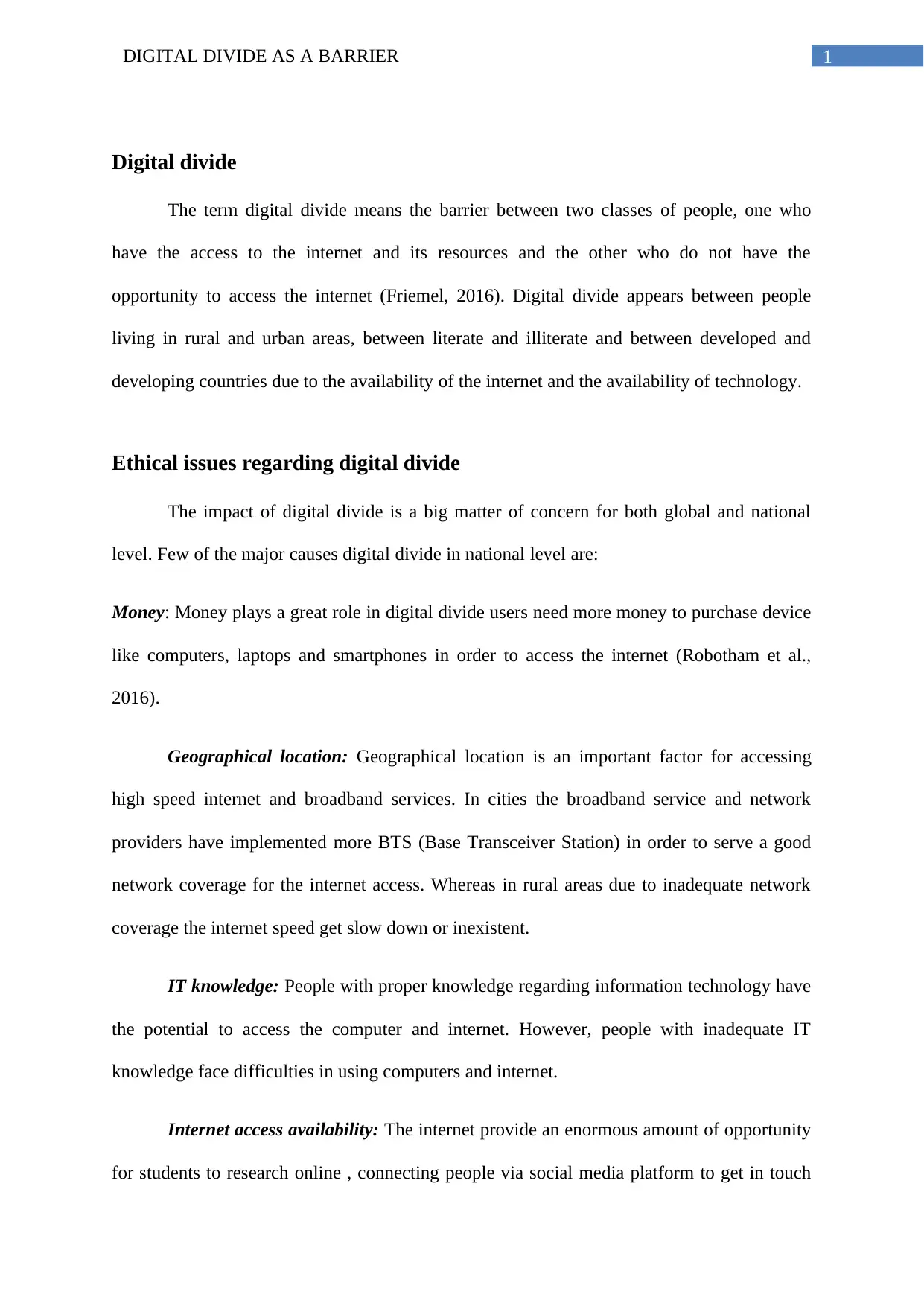
1DIGITAL DIVIDE AS A BARRIER
Digital divide
The term digital divide means the barrier between two classes of people, one who
have the access to the internet and its resources and the other who do not have the
opportunity to access the internet (Friemel, 2016). Digital divide appears between people
living in rural and urban areas, between literate and illiterate and between developed and
developing countries due to the availability of the internet and the availability of technology.
Ethical issues regarding digital divide
The impact of digital divide is a big matter of concern for both global and national
level. Few of the major causes digital divide in national level are:
Money: Money plays a great role in digital divide users need more money to purchase device
like computers, laptops and smartphones in order to access the internet (Robotham et al.,
2016).
Geographical location: Geographical location is an important factor for accessing
high speed internet and broadband services. In cities the broadband service and network
providers have implemented more BTS (Base Transceiver Station) in order to serve a good
network coverage for the internet access. Whereas in rural areas due to inadequate network
coverage the internet speed get slow down or inexistent.
IT knowledge: People with proper knowledge regarding information technology have
the potential to access the computer and internet. However, people with inadequate IT
knowledge face difficulties in using computers and internet.
Internet access availability: The internet provide an enormous amount of opportunity
for students to research online , connecting people via social media platform to get in touch
Digital divide
The term digital divide means the barrier between two classes of people, one who
have the access to the internet and its resources and the other who do not have the
opportunity to access the internet (Friemel, 2016). Digital divide appears between people
living in rural and urban areas, between literate and illiterate and between developed and
developing countries due to the availability of the internet and the availability of technology.
Ethical issues regarding digital divide
The impact of digital divide is a big matter of concern for both global and national
level. Few of the major causes digital divide in national level are:
Money: Money plays a great role in digital divide users need more money to purchase device
like computers, laptops and smartphones in order to access the internet (Robotham et al.,
2016).
Geographical location: Geographical location is an important factor for accessing
high speed internet and broadband services. In cities the broadband service and network
providers have implemented more BTS (Base Transceiver Station) in order to serve a good
network coverage for the internet access. Whereas in rural areas due to inadequate network
coverage the internet speed get slow down or inexistent.
IT knowledge: People with proper knowledge regarding information technology have
the potential to access the computer and internet. However, people with inadequate IT
knowledge face difficulties in using computers and internet.
Internet access availability: The internet provide an enormous amount of opportunity
for students to research online , connecting people via social media platform to get in touch
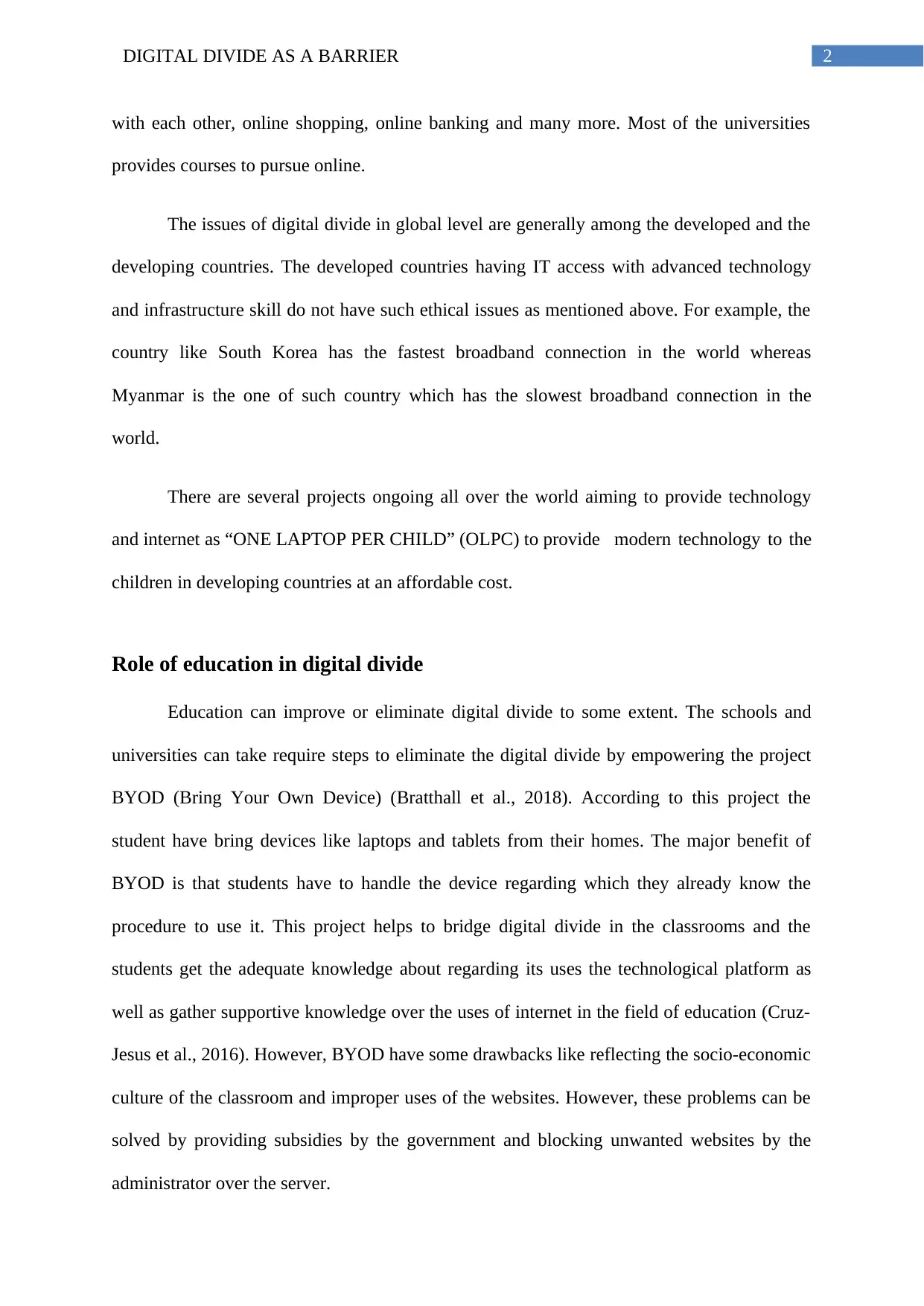
2DIGITAL DIVIDE AS A BARRIER
with each other, online shopping, online banking and many more. Most of the universities
provides courses to pursue online.
The issues of digital divide in global level are generally among the developed and the
developing countries. The developed countries having IT access with advanced technology
and infrastructure skill do not have such ethical issues as mentioned above. For example, the
country like South Korea has the fastest broadband connection in the world whereas
Myanmar is the one of such country which has the slowest broadband connection in the
world.
There are several projects ongoing all over the world aiming to provide technology
and internet as “ONE LAPTOP PER CHILD” (OLPC) to provide modern technology to the
children in developing countries at an affordable cost.
Role of education in digital divide
Education can improve or eliminate digital divide to some extent. The schools and
universities can take require steps to eliminate the digital divide by empowering the project
BYOD (Bring Your Own Device) (Bratthall et al., 2018). According to this project the
student have bring devices like laptops and tablets from their homes. The major benefit of
BYOD is that students have to handle the device regarding which they already know the
procedure to use it. This project helps to bridge digital divide in the classrooms and the
students get the adequate knowledge about regarding its uses the technological platform as
well as gather supportive knowledge over the uses of internet in the field of education (Cruz-
Jesus et al., 2016). However, BYOD have some drawbacks like reflecting the socio-economic
culture of the classroom and improper uses of the websites. However, these problems can be
solved by providing subsidies by the government and blocking unwanted websites by the
administrator over the server.
with each other, online shopping, online banking and many more. Most of the universities
provides courses to pursue online.
The issues of digital divide in global level are generally among the developed and the
developing countries. The developed countries having IT access with advanced technology
and infrastructure skill do not have such ethical issues as mentioned above. For example, the
country like South Korea has the fastest broadband connection in the world whereas
Myanmar is the one of such country which has the slowest broadband connection in the
world.
There are several projects ongoing all over the world aiming to provide technology
and internet as “ONE LAPTOP PER CHILD” (OLPC) to provide modern technology to the
children in developing countries at an affordable cost.
Role of education in digital divide
Education can improve or eliminate digital divide to some extent. The schools and
universities can take require steps to eliminate the digital divide by empowering the project
BYOD (Bring Your Own Device) (Bratthall et al., 2018). According to this project the
student have bring devices like laptops and tablets from their homes. The major benefit of
BYOD is that students have to handle the device regarding which they already know the
procedure to use it. This project helps to bridge digital divide in the classrooms and the
students get the adequate knowledge about regarding its uses the technological platform as
well as gather supportive knowledge over the uses of internet in the field of education (Cruz-
Jesus et al., 2016). However, BYOD have some drawbacks like reflecting the socio-economic
culture of the classroom and improper uses of the websites. However, these problems can be
solved by providing subsidies by the government and blocking unwanted websites by the
administrator over the server.
⊘ This is a preview!⊘
Do you want full access?
Subscribe today to unlock all pages.

Trusted by 1+ million students worldwide
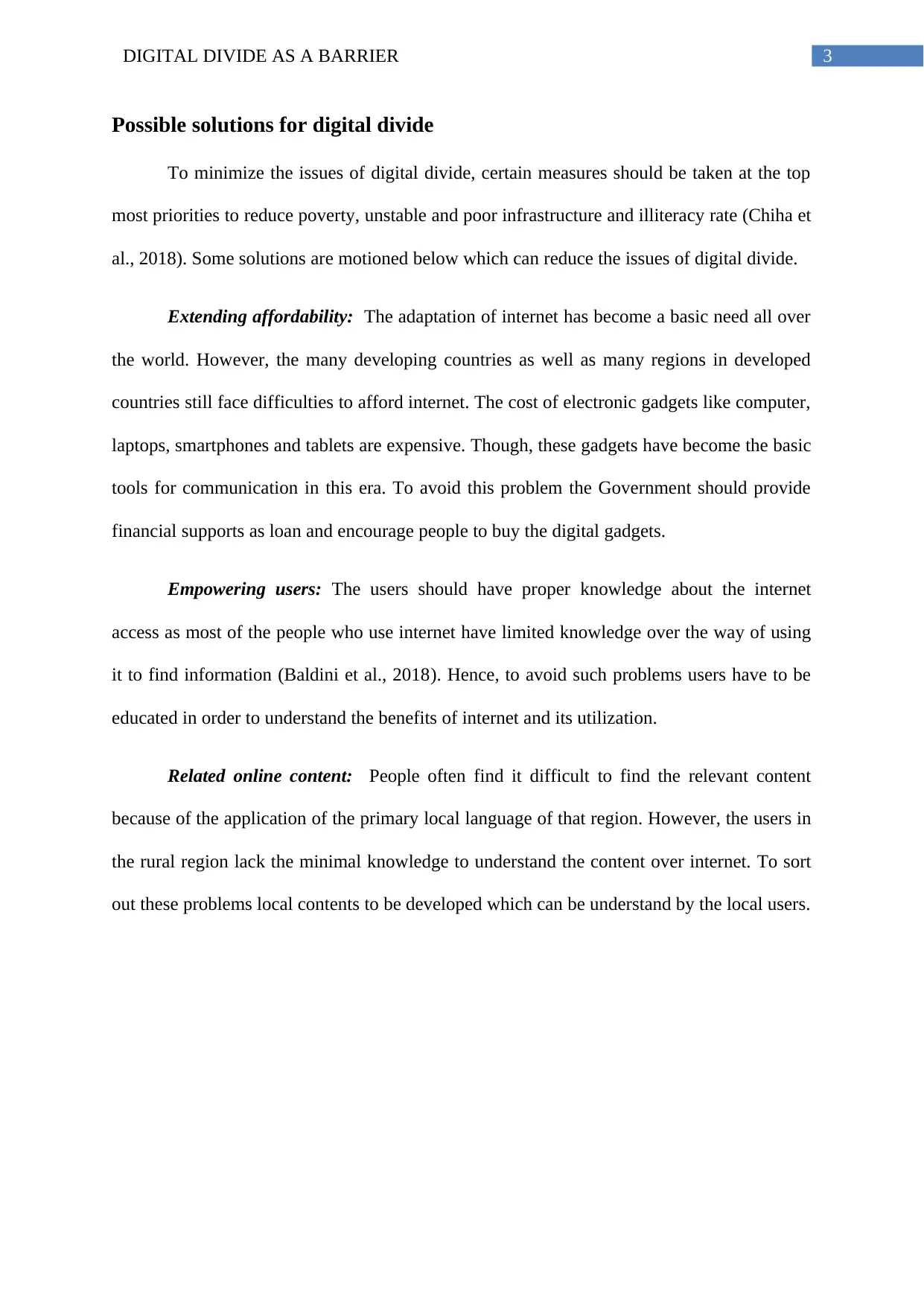
3DIGITAL DIVIDE AS A BARRIER
Possible solutions for digital divide
To minimize the issues of digital divide, certain measures should be taken at the top
most priorities to reduce poverty, unstable and poor infrastructure and illiteracy rate (Chiha et
al., 2018). Some solutions are motioned below which can reduce the issues of digital divide.
Extending affordability: The adaptation of internet has become a basic need all over
the world. However, the many developing countries as well as many regions in developed
countries still face difficulties to afford internet. The cost of electronic gadgets like computer,
laptops, smartphones and tablets are expensive. Though, these gadgets have become the basic
tools for communication in this era. To avoid this problem the Government should provide
financial supports as loan and encourage people to buy the digital gadgets.
Empowering users: The users should have proper knowledge about the internet
access as most of the people who use internet have limited knowledge over the way of using
it to find information (Baldini et al., 2018). Hence, to avoid such problems users have to be
educated in order to understand the benefits of internet and its utilization.
Related online content: People often find it difficult to find the relevant content
because of the application of the primary local language of that region. However, the users in
the rural region lack the minimal knowledge to understand the content over internet. To sort
out these problems local contents to be developed which can be understand by the local users.
Possible solutions for digital divide
To minimize the issues of digital divide, certain measures should be taken at the top
most priorities to reduce poverty, unstable and poor infrastructure and illiteracy rate (Chiha et
al., 2018). Some solutions are motioned below which can reduce the issues of digital divide.
Extending affordability: The adaptation of internet has become a basic need all over
the world. However, the many developing countries as well as many regions in developed
countries still face difficulties to afford internet. The cost of electronic gadgets like computer,
laptops, smartphones and tablets are expensive. Though, these gadgets have become the basic
tools for communication in this era. To avoid this problem the Government should provide
financial supports as loan and encourage people to buy the digital gadgets.
Empowering users: The users should have proper knowledge about the internet
access as most of the people who use internet have limited knowledge over the way of using
it to find information (Baldini et al., 2018). Hence, to avoid such problems users have to be
educated in order to understand the benefits of internet and its utilization.
Related online content: People often find it difficult to find the relevant content
because of the application of the primary local language of that region. However, the users in
the rural region lack the minimal knowledge to understand the content over internet. To sort
out these problems local contents to be developed which can be understand by the local users.
Paraphrase This Document
Need a fresh take? Get an instant paraphrase of this document with our AI Paraphraser
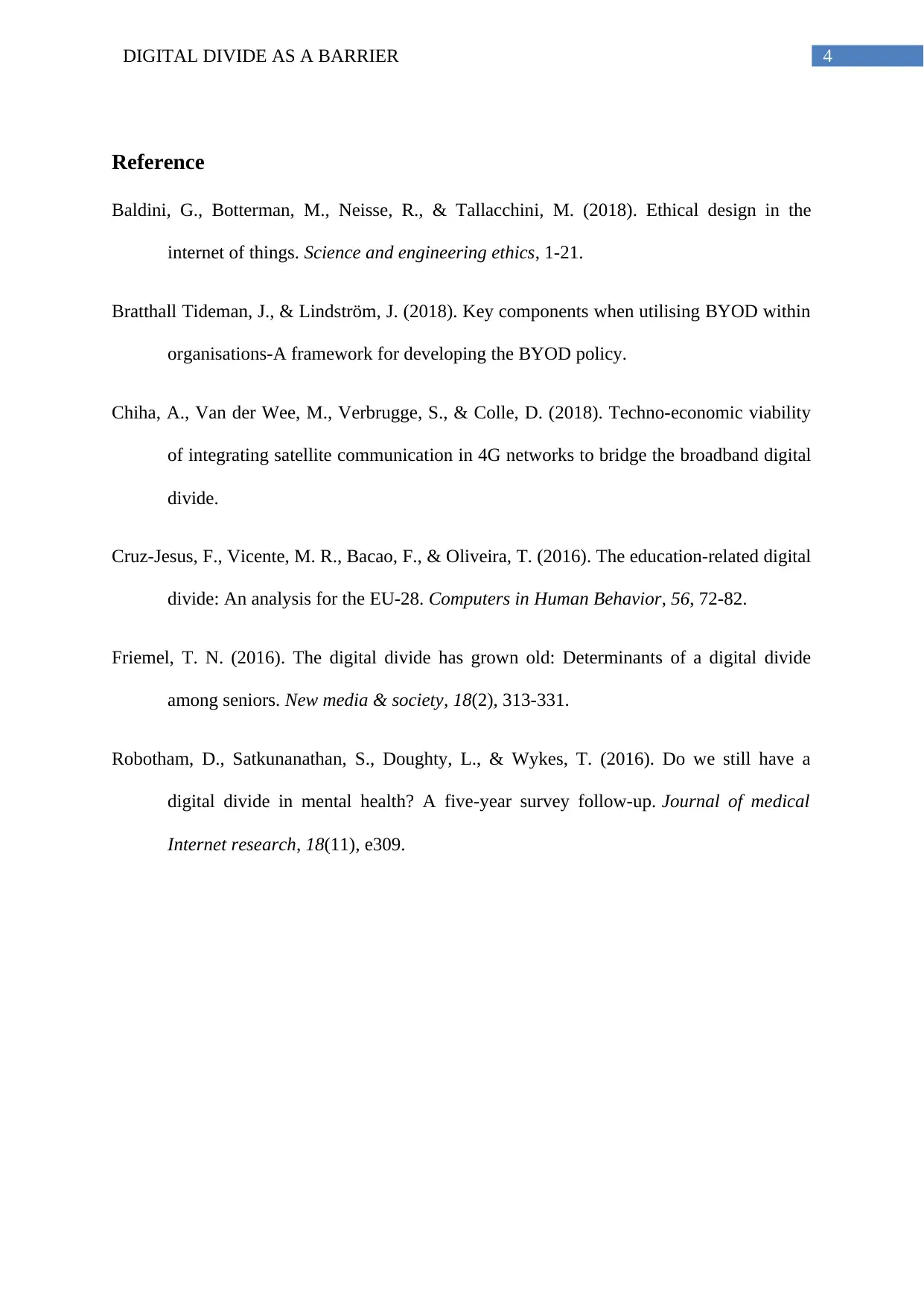
4DIGITAL DIVIDE AS A BARRIER
Reference
Baldini, G., Botterman, M., Neisse, R., & Tallacchini, M. (2018). Ethical design in the
internet of things. Science and engineering ethics, 1-21.
Bratthall Tideman, J., & Lindström, J. (2018). Key components when utilising BYOD within
organisations-A framework for developing the BYOD policy.
Chiha, A., Van der Wee, M., Verbrugge, S., & Colle, D. (2018). Techno-economic viability
of integrating satellite communication in 4G networks to bridge the broadband digital
divide.
Cruz-Jesus, F., Vicente, M. R., Bacao, F., & Oliveira, T. (2016). The education-related digital
divide: An analysis for the EU-28. Computers in Human Behavior, 56, 72-82.
Friemel, T. N. (2016). The digital divide has grown old: Determinants of a digital divide
among seniors. New media & society, 18(2), 313-331.
Robotham, D., Satkunanathan, S., Doughty, L., & Wykes, T. (2016). Do we still have a
digital divide in mental health? A five-year survey follow-up. Journal of medical
Internet research, 18(11), e309.
Reference
Baldini, G., Botterman, M., Neisse, R., & Tallacchini, M. (2018). Ethical design in the
internet of things. Science and engineering ethics, 1-21.
Bratthall Tideman, J., & Lindström, J. (2018). Key components when utilising BYOD within
organisations-A framework for developing the BYOD policy.
Chiha, A., Van der Wee, M., Verbrugge, S., & Colle, D. (2018). Techno-economic viability
of integrating satellite communication in 4G networks to bridge the broadband digital
divide.
Cruz-Jesus, F., Vicente, M. R., Bacao, F., & Oliveira, T. (2016). The education-related digital
divide: An analysis for the EU-28. Computers in Human Behavior, 56, 72-82.
Friemel, T. N. (2016). The digital divide has grown old: Determinants of a digital divide
among seniors. New media & society, 18(2), 313-331.
Robotham, D., Satkunanathan, S., Doughty, L., & Wykes, T. (2016). Do we still have a
digital divide in mental health? A five-year survey follow-up. Journal of medical
Internet research, 18(11), e309.
1 out of 5
Related Documents
Your All-in-One AI-Powered Toolkit for Academic Success.
+13062052269
info@desklib.com
Available 24*7 on WhatsApp / Email
![[object Object]](/_next/static/media/star-bottom.7253800d.svg)
Unlock your academic potential
Copyright © 2020–2025 A2Z Services. All Rights Reserved. Developed and managed by ZUCOL.





